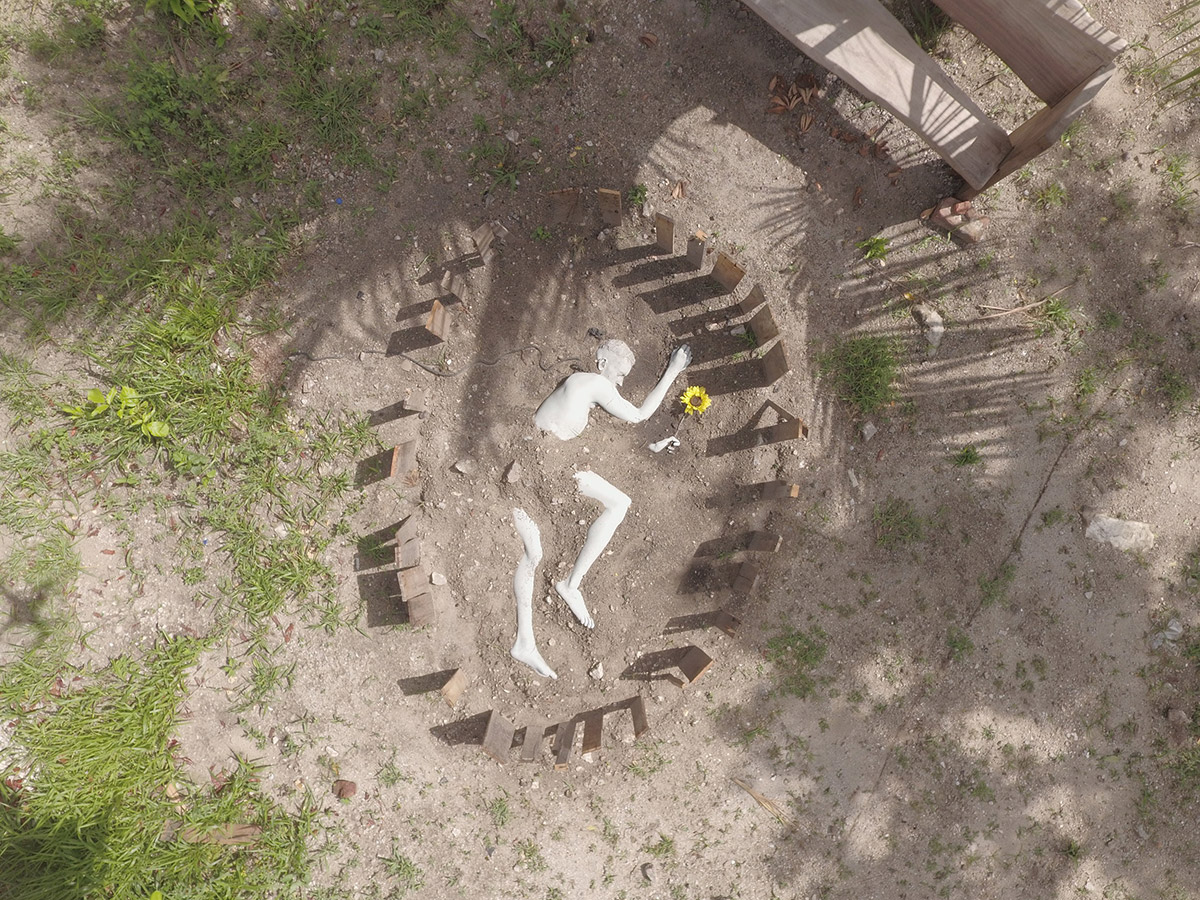
Dr. Ian Bethell-Bennett writes about unearthing voices and two central projects of the National Exhibition 8, Edrin Symonette’s ‘Residue of a Colonia Past’ and Keisha Oliver’s “Porch Conversations’.

Edrin Symonette. Residue of a Colonial Past. Installation view at NAGB Sculpture Garden.
Colours are covering us in a suffocating noose of enslavement. As the nation retreats to its coloured sides, leaving neighbourhoods to rot with abandonment, we fall victim to the death of forgetting. The quickest way to kill our culture is to forget, to neglect, to deny, and in so doing we destroy all visible traces of us. There are stories that lay hidden in the rubble of quiet revolution and the order of politeness. These stories, however, are emerging from their burial sites and forming new voices. Many may not be aware of them; many may not know the history, much more will not know the history of place because “It is the half that has never been told, some of us must tell it.”
The Eighth National Exhibition at the National Art Gallery of The Bahamas and Hillside House has provided much insight into Bahamian art and culture and what inhabits our imaginations. The Exhibitions opened on December 15th and 17th respectively with large crowds and both events boasted numbers of disturbing waves cloaked in revelatory work.
Edrin Symonette’s installation of a partially unearthed sculpture ‘Residue of a Colonial Past on the hilltop of Hospital Lane, or the NAGB Sculpture Garden, disturbs the silence around buried pasts and the voices silenced by this burial. It is by accident that we as a people stumble upon our buried pasts, even when we know it is there. It also unearths a need to teach history and not a tepid version of history that eclipses all the major Bahamian, Black, African events with the arrival of Christopher Columbus and the extinction of indigenous people. History began before Columbus and did not end with him.
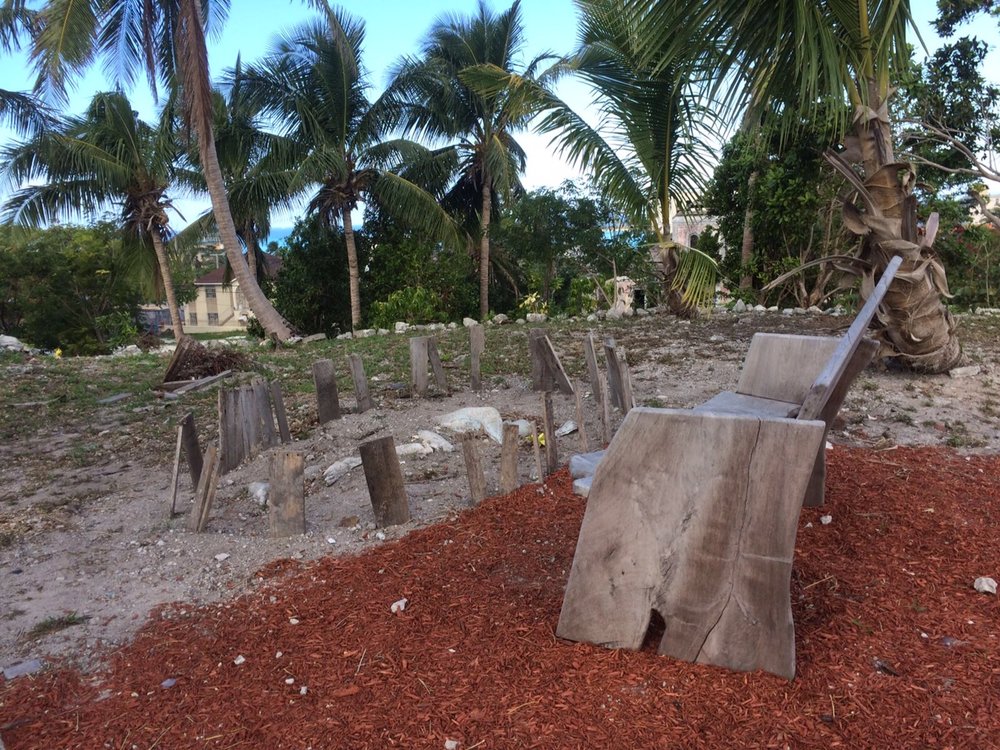
Edrin Symonette. Detail of Residue of a Colonial Past.
The silencing of the African past goes hand in glove with the dispossession of many peoples of African descent, though we choose not to talk about it. As the old ways die out so to do the old stories and habits. We do not ‘know’ about the distinction between Africans and Europeans on the island, where a hospital provided service to one group of people over the other. We do not discuss the difference in affordable health care and that which is out of reach to most except if they wait for a bed or death, whichever comes first. These discussions are buried under the layers of silence and politeness.
Symonnette’s work unearths some of this past. It pushes us to uncover so much of what lays a few inches beneath the surface which we are happy to pave over. This is akin to what Édouard Glissant examines as the ‘Poetics of Relation’ or how we relate with one another and ourselves. He also examines our relationship with our home, the land we have been taught not to own or belong on because it is the sight of suffering. In theorizing on the Martinican, Glissant observes in a collection of essays titled ‘Caribbean Discourse’ that, “The Martinican never has the foresight or the unconscious urge to take control of this space. Any group that is limited by the stubborn inability to take control of its surroundings is a threatened group”.
By covering over the stories of our past, we become a threatened group. The identity of the group is erased through repeated de-historicisation or the removal of history from our lexicon.
As silence grows and dissent surfaces like bitter bile in our mouths, art allows the space to create voice, not silence. Symonette creates art that disturbs the assumed peace, docility or placidity of the idea, the imaginings of us as an easy-going, laid-back people. All inhabitants of paradise are by nature docile. We protest, not, our bones being removed from their resting places, graveyards being sold to a community to the north and therein paved over, turned into condominiums for exclusively offshore sale. Bones are easily hidden under buildings. Forts are easily built over by car parks. Memory is easily annexed into the annals of what never was. Symonnette’s piece grapples with this tension.
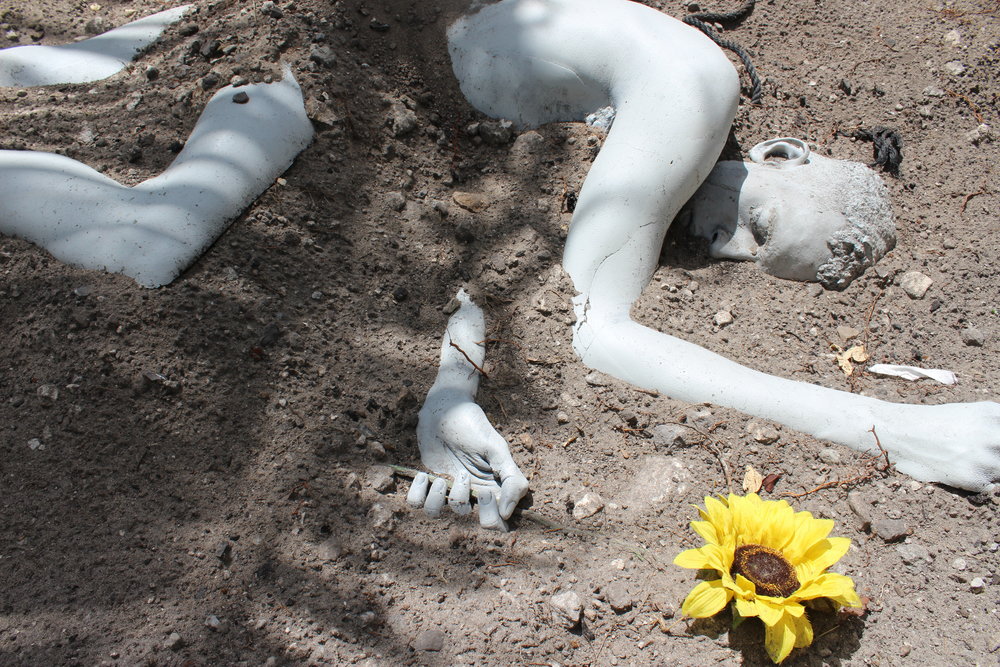
Edrin Symonette. Detail of Residue of a Colonial Past.
The tension between belonging and not, of speaking and not, of accepting and not. The tension between being denied the space to speak and the desire to occupy a place of voice. Though Bay Street will no longer be of access to you, it has been sanitised in significant ways, made fit for consumption. The body that lay at the top of Hospital Lane where an old hospital once stood is not real, but its unreality allows us to ask questions of our history. Art, in this case, is the stand-in for absence.
There is an interesting and significant link between Symonette’s work and an installation by graphic artist and educator Keisha Oliver who explores life on the porch. As many people who grew up in – Bain Town, Grant’s Town, Delancey Town, Charles Town – community porches were an integral part of life, and not because they were pretty or elaborate, but because they were the beginning of the home and the space where most of the social interaction occurred. The space was sacred because it provided shade for small front rooms, and space to converse, to explore to share and to greet, and most of all to bring life into the home and the home into the street. It broke down barriers.
“Porch Conversations” captures our past and the tensions between its devastation and its survival, though not easily, or ignoring the obvious distrust being sown into everyday lives. The lack of porch conversations has a detrimental impact on cultural longevity and resilience. It is a part of our inability to relate that is theorized in the poetics of relations. Our need to relate to one another and to the space we inhabit is key to our survival as a people.
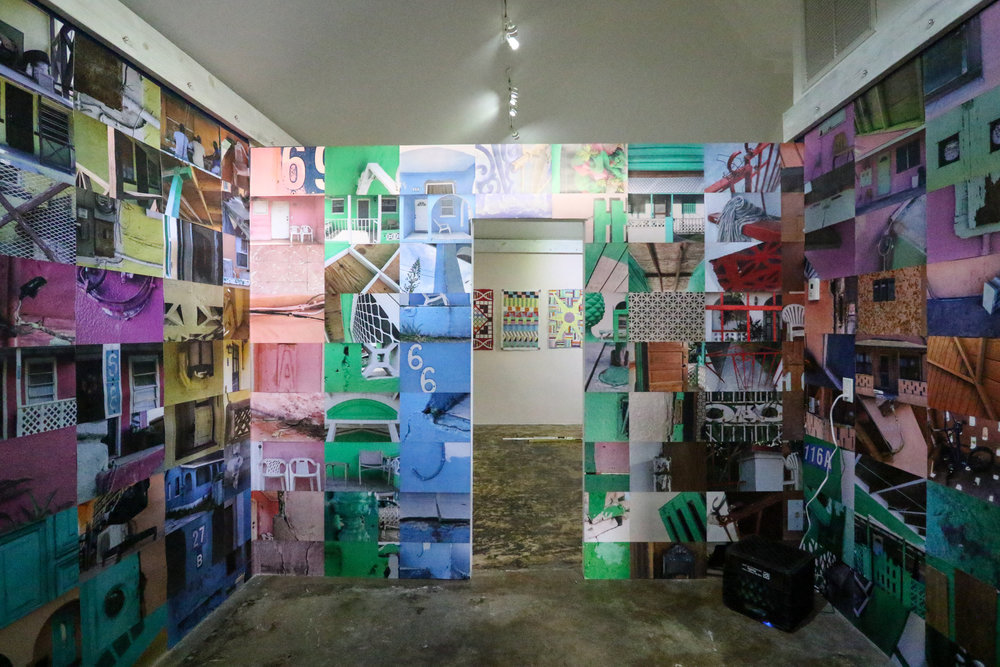
Keisha Oliver. Porch Conversations. On view at Hillside House, part of the NE8 OFFsite exhibition.
This space is dying, being replaced by tightly sealed hurricane-proof windows and doors that lock in the cool breeze and lock out the undesired heat of global warming and all the conversations that happen outside. As the art of conversation dies out we find ourselves caught in a position where we can no longer relate.
Our poetics of space and the memory of place are served by these pieces, though nothing may be done to stem the loss of culture, these may begin a conversation that is not only about environmental preservation but also about cultural and national survival. As the state junks the nation, where does the nation find a space to speak of its woes, its cares if not in the streets?
Using the streets is historically important to the national development of the country, which is why, in part, the ability of government to ‘control’ the space speaks again to Glissant’s note that people who cannot control their space are under threat. The arts are speaking, the artists are creating dangerously, but where is the community?
As we transition into a place where native culture is frowned upon in favour of international culture, as Timothy Rommen points out in Funky Nassau: Roots, routes and representation in Bahamian popular music Bahamian culture, and especially Bahamian music, has succumbed to tourism culture where local bars and clubs disappear in favour of hotel lobbies and lounges. This is disturbing when we take for granted that tourism is about creating and fostering a unique culture that invites others into our country.
Today, we understand that tourism is actually about cultural erasure unless the culture is so strong that it can resist the pressure to become Las Vegas. Two things assist in this resistance to erasure, notwithstanding the tensions they create, these are the outlets for true or real Bahamian creative expression, and the encouragement of the arts. These find confluence in NE8 and the artworks.
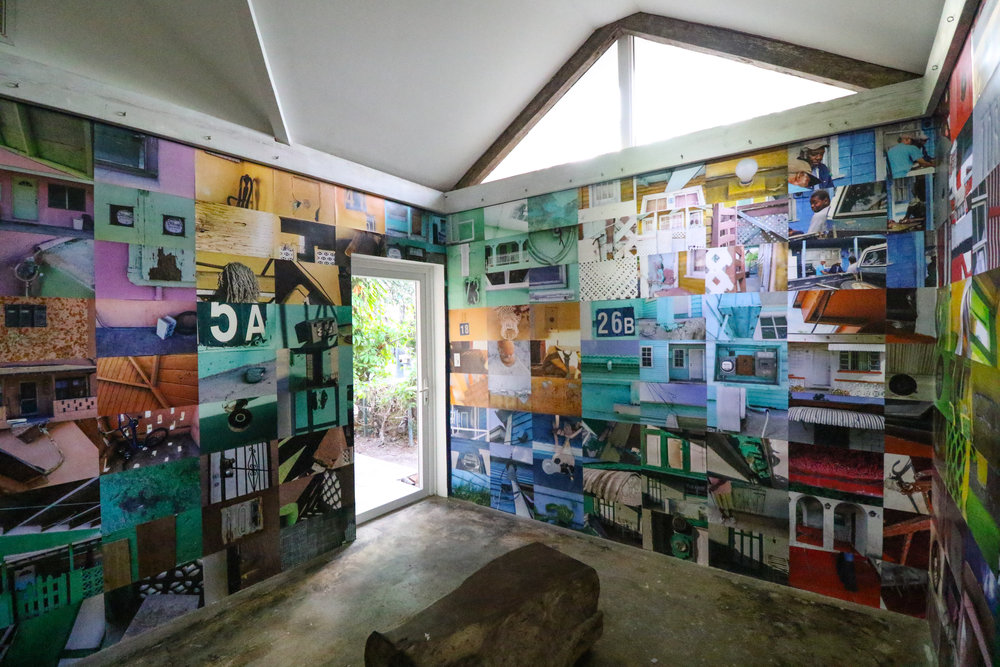
Keisha Oliver. Porch Conversations. On view at Hillside House, part of the NE8 OFFsite exhibition.
Today’s focus has been on the unearthing of cultural erasure or a buried identity and expression that is continually subsumed under bodies that resist exploitation but are silenced by majority empowerment. It is culturally significant that Oliver’s ‘Porch Conversations’ and Symonette’s ‘Residue of a Colonial Past’ articulate the need to remember, to put back together the past that has been deconstructed, ripped away from us.
Trinh H. Minh-Ha offers:
Let me tell you a story. For all I have a story. Story passed on from generation to generation, named Joy. Joy inherent in the process of storytelling. Whoever understands it also understands that a story, as distressing as it can be in it’s joy, never takes anything away from anybody. It’s name, remember, is Joy. (1989, p. 119)
This is our story, a story that as poet Lorna Goodison argues has been sealed over with blood wax:
Mother, one stone is wedged across the hole in our history
and sealed with blood wax.
In this hole is our side of the story…
When colonialism ended, we were told that our story would be history. Our stories are covered over by dirt and are stepped on by the boots that insist on it being silenced. The buried African figure, lying semi-unearthed at the top of the hill speaks to a history and with it a culture lost to silence. All of this makes up our national storytelling; only we must come to the table and sit to hear it and we must open our ears. We must allow the story to survive the insistence on coloured camps, respectable politics, and representation of us as well mannered, good natives whose place is known and who refuse to break ranks to create dangerously.
Breaking ranks means speaking out, causing discomfort and speaking stories that enliven history suppressed under the stones of silence. The hole may be a grave, the African graves may be forgotten, overlooked, neglected but they shall never be fully erased. The poetics of relation may argue that we are under threat, which the culture is, but we can choose to refuse to bow to that threat and to create flamboyantly a culture that is alive and boisterous as much as it upsets polite society.
Africanness in The Bahamas upsets polite society; porch conversations speak to sip-sip that passes easily through our fingers and falls into the hole over which the rock will once again slide. We have a moment of being that is precious, we must unearth ourselves through unearthing and telling our stories.